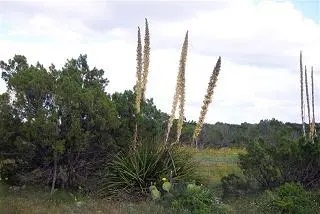NICE! Plant of the Month
(Dasylirion spp.)

Family: Agavaceae
Other Common Names: Desert Spoon
Type: Shrub. Large clumps of evergreen, yucca-like leaves.
Natural Habitat: Limestone hills and hillsides in Central and South Texas, West Texas into New Mexico and Dry hillsides in the Edwards Plateau and Trans-Pecos, and Northern Mexico. D. texanum is a common roadside plant in the Hill Country.
Growth: 2-3 feet in height and in diameter, tall (9’-15’) flower spikes
Deer Resistance: Completely ignored by deer
Wildlife: Bighorn Sheep browse sotol. Sotol supports various pollinator bees that are essential to food production and increased biodiversity, thus enhancing the well-being of both people and wildlife.
Light Tolerance: Light shade to full sun
Flowers: Very tall narrow 9’-15’ spikes of small flowers in summer
Fruit: Shell-covered seed
Leaves: Narrow, pliable leaves, toothed or spined, blue-green or green
Water Requirements: Very Low
Soil Requirements: Well-drained sites; sand, loam, clay, caliche, limestone
Planting Instructions: Space plants 5 feet apart to maximize the appeal of their symmetrical shape. Dig a hole at least two times wider than, but the same depth as the root ball in the nursery container. Sides of the hole should be irregular, not smooth. Remove plant from container, taking care to support the root ball. Loosen exterior roots gently with your fingers. If the plant is root-bound and cannot be loosened by hand, the outer roots may be cut in several places. Lift the plant by the root ball and place into the hole. Backfill hole, using soil that was dug out. Do not add any soil to the top of the root ball. Gently firm the soil with your hands, but do not tamp it down. Place 3-4 inches of mulch over the bare soil around, but not touching the base of the plant.
Watering Instructions: Water deeply after planting to settle soil around roots. Then every 7-10 days, as needed, during the first growing season. Before watering, check for soil moisture at a depth of an inch or two at the edge of the root ball. Skip a watering after a rainfall of ½ to 1 inch. Maintain this watering schedule until the first fall. In a “normal” year, no watering may be necessary during the fall and winter, but during a dry period, monthly watering may be needed. Second Spring and thereafter: Water monthly only during periods of drought. Once established, this native will survive with no supplemental irrigation.
NICE! Tip: Texas has three species of the incredibly tough, drought–loving Dasylirion: beautiful blue D. wheeleri, green D. texanum (the Hill country sp.) and the ferociously-toothed D. leiophyllum. Though all three spp. are not native to the whole state, all three kinds will grow almost all over Texas. Use as you would any yucca-like plant for their structural drama and beautiful symmetrical appearance. Sotol’s fibrous leaves have been used for matting, ropes, baskets and even emergency cattle feed. The roasted flower heads have been used to produce a liquor called sotol.
Look for the NICE! Plant of the Month signs and information sheets on your next visit to a participating Boerne nursery. And thank you for supporting native plants by using them in your landscapes.
